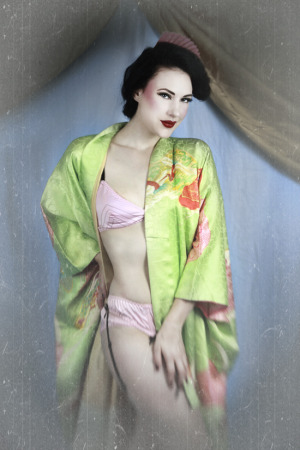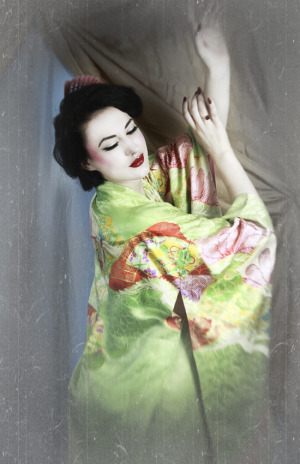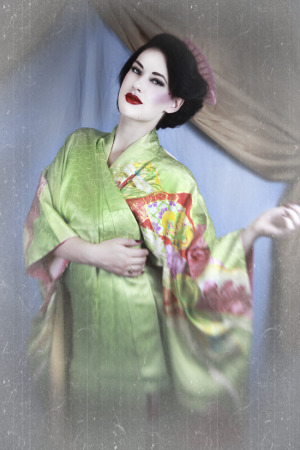The kimono

Kimono literally means “the thing to wear” (ki “wear” and mono “thing”), which was first used in everyday language in the mid-19th century. Prior to this, the traditional garment was only known as a kosode, meaning ‘small sleeve’. Kimono are straight-seamed robes that are wrapped around the body, left side over right, and secured with a sash known as an obi, which is tied at the back. Generally worn to the ankle, the length of the garment can be altered by drawing material up underneath the obi. The wrap style and loose fabric has been developed to cohere to the culture’s lifestyle and climate; many activities are performed while seated on the floor.
The style of traditional kimono also varies between women, men and children, and also indicates whether the female wearer is married. Young women’s kimonos, known as a furisode, have longer sleeves and tend to be more elaborate than the older, married woman’s garment. It is said that the traditional reason for the sleeves is that when replying to a man, she waves the sleeves back and forth for ‘yes’, and left to right for ‘no’.
The pattern of the kimono rather than the cut of the fabric acts as an indicator of social status; the more extravagant the pattern, the wealthier the wearer. Formality is also determined by accessories, the fabric and the number of family crests (kamon) adorning the garment. Silk was the most desirable of fabrics, with only the most privileged able to wear such luxury regularly. The majority of Japanese society would only have the chance to wear silk kimono on special occasions, sometimes being forbidden to do so all together.
Today, it is mostly women that continue to wear kimono, and usually only on special occasions. During the late 19th century, traditional garments were gradually replaced by more convenient Western clothing and Yukata, a casual, thin style of kimono. The decline in the heavier garments seemed to happen as Eastern culture filtered through to the West, and vice versa. One slightly morbid urban myth suggests that the decline in kimono was encouraged by the 1932 fire at Shirokiya’s Nihonbashi store. Women did not tend to wear underwear under their kimono, and several women were said to refuse to jump into the safety nets for fear of exposing themselves!

The wrap style of the kimono has become an integral part of international fashion, influential throughout the West. From the Victorian period onward, Europe had a fascination with the exotic East, with stars such as Anna May Wong gracing the silver screen. To Western women the kimono seemed an ideal new garment that allowed freedom of movement, contrasting with the corseted, petticoat-clad style of the period. American interest in the kimono diminished in the tense years prior to WW2, however, souvenir kimono from returning GI’s rekindled the interest. During the 1950s, kimono and kimon-inspired gowns were popular, both as loungewear and daily wear.
If you want to grab one of these gorgeous vintage kimono for yourself, make sure you visit our boutique in Brick Lane. We currently have a selection of one-of-a-kind silk kimono starting at £150; one of which you can see modelled by the gorgeous Miss Betsy Rose above and below!

